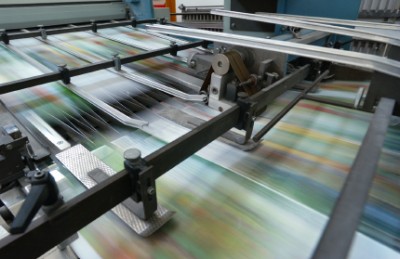
Political Direct Mail Starts with Paper Stock
Any printer can give you paper—commonly referred to as “stock”—that is lying around the shop. But when it comes to what paper stock is available for your political direct mail, there are as many choices as there are types of drinks at your favorite coffee shop. Each paper type has specific characteristics that influence printability, color, texture, and price. So, don’t order a pumpkin spice latte when you actually want a triple shot latte with oat milk (in case anyone wants to help keep me caffeinated). Your paper stock should fit your direct mail needs, including your budget and design aesthetic (e.g. do you want the piece to look slick or more organic?).
Paper has a huge influence on the final printed piece. Communicating your needs and preferences to your printer is key to finding the right paper stock for the job. Ask for printed samples in advance so you know exactly what to expect from the paper and how it prints.
There are some great online resources about paper stock from paper manufacturers that provide a wealth of information. Check out this quick guide to choosing paper from Mohawk Papers for some bonus points.
Coated or Uncoated?
Most political direct mail ends up on a coated paper stock. This is for a couple of reasons, namely that coated stocks dry faster and tend to come in at a lower price point. To create coated stock, paper is coated with a white clay or filler material that’s calibrated to obtain a hard, smooth printing surface. Coated papers are less porous, allowing ink to sit better on top of the sheet. If you’re doing a piece that has heavy ink coverage and full color photography in the design, often you will want to use a coated stock.
Coated stocks typically come in silk or gloss finishes (though there are many other options available). Spoiler, gloss cover provides a glossy look (are you shocked?) and smooth feel, while something like a silk cover can provide you with a duller look and grainier feel.
Uncoated stocks typically provide a rougher feel that’s noticeable to the touch. It’s also more porous and absorbent compared to a coated stock.
In terms of the price implications, while it may seem like it would be cheaper to use an uncoated paper, typically an uncoated stock is more expensive than a coated stock since its less commonly used.
Text vs. Cover
Typically, political direct mail comes on cover stock (also referred to as card stock)—it’s heavier and meets postal regulations for oversize flats (e.g. the ubiquitous 8.5 x 11 mailer). Text weight paper may be used for pieces that fold (for instance, an #80 text when folded for an 11 x 17 one-fold mailer), but is otherwise too flimsy to mail as an unfolded flat. Typically, at TCW, we opt for a thinner cover stock for folded pieces, instead of using text weight paper, just because we feel it provides voters with a better experience at the mailbox. Which brings us to weights and thickness.
Weights
There’s also a whole world of paper thicknesses to consider when choosing paper for your political direct mail printing. Paper thickness is determined by a number that indicates the pound. Two common thicknesses for political direct mail postcards are #80 and #100 (read as eighty pound and one hundred pound, respectively). Jumbo postcard sizes like 8.5 x 11s often do well with a thicker, more substantial paper stock like a #100. You may instead often choose a stock like a #80 that’s a bit thinner if you’re doing a piece that folds (folding a thicker paper can cause it to tear). Paper thickness can really matter when it comes to your political direct mail program, because you want your piece to seem substantial in the mailbox and stand apart from the other pieces that will have the consistency of a thin piece of regular home printer paper.
The weight of your political direct mail pieces matter to the USPS because it effects how the mail moves through the post office workflow. The paper must have enough durability not to be torn up with the mass of other mail during handling, or by machines, etc. Thicker paper usually fares better in the mail system and is in better shape when it reaches mailboxes.
Heavier paper is perceived as more expensive and higher-end than flimsy lighter paper, which may have an impact on how voters interact with and perceive your mail.
What does “#”actually mean?
Like other types of measurements around the world, there are different terms and formulation for paper weights (this is probably why there is confusion around the issue.)
The U.S. Basis Weight is defined as the weight of 500 sheets, known as a ream, of paper, in pounds, in its basic unit uncut size. The problem with this measurement is that different types of paper come in different basic sheet sizes, so measuring paper weight is not always measuring apples to apples.
There’s a helpful guide to thinking through paper weight here if you want to really dig in on this, but the TLDR version is that #60 text and #60 cover will not feel the same in terms of thickness and sturdiness.
The USPS does not actually tell you to use a certain weight paper, but your pieces need to fall into guidelines for the type of mail and standard you -are sending. Your postage is based on you meeting the guidelines.
So what paper do I need for political direct mail?
So, what’s the right type of paper for your political direct mail printing? While it does depend on your budget, goals and desired aesthetic, if you’re mailing an 8.5 x 11 flat, you’re probably going to be looking at an #80 or #100 coated stock (choose your own adventure with the finish!).
Printing, paper or general political direct mail questions? Drop us a line!